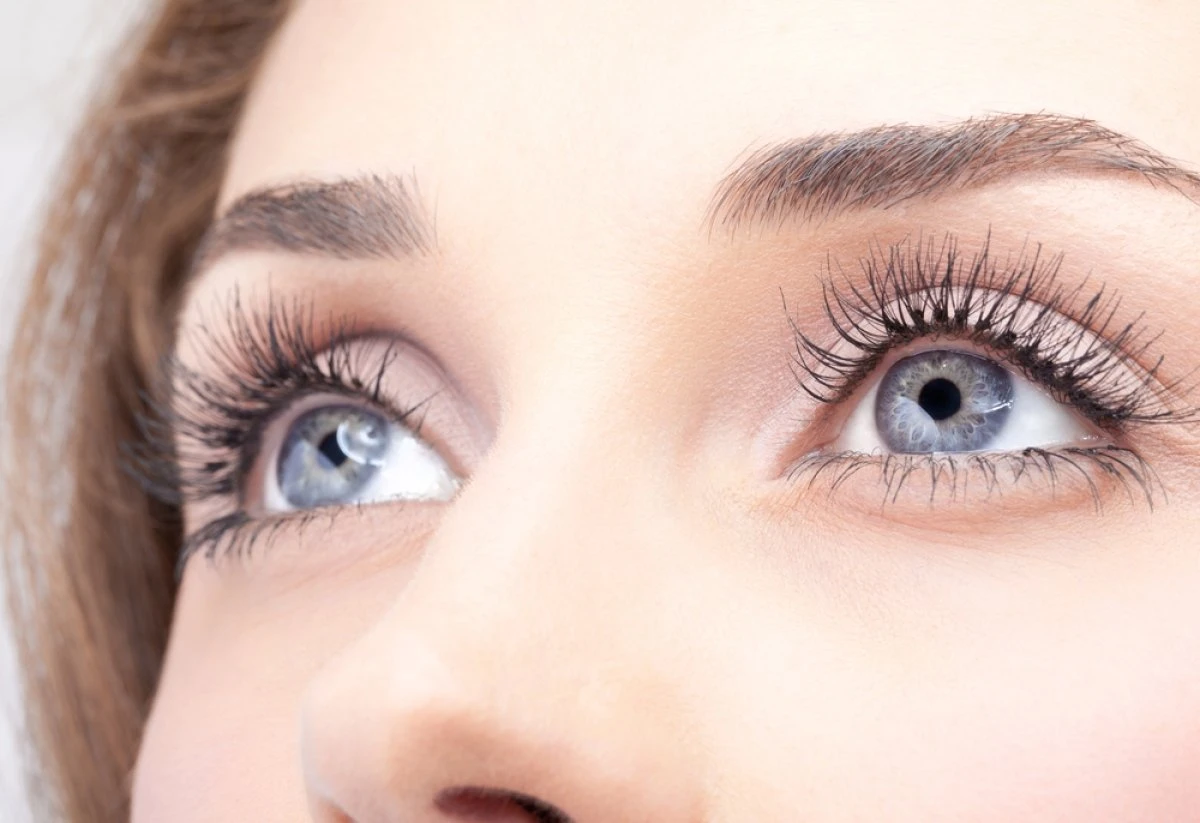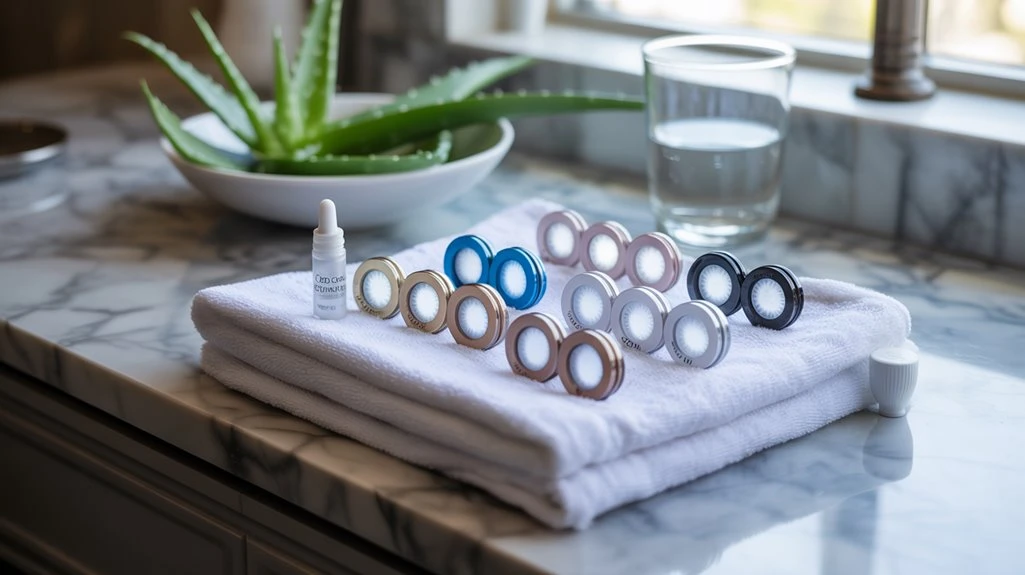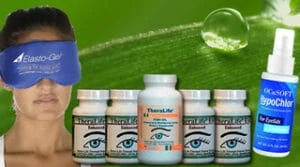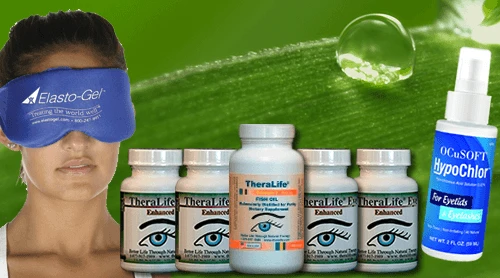For those dealing with dry eyes, while there are several contact lens options like Acuvue Oasys with Hydraclear Plus and Dailies Total1 Water Gradient, TheraLife offers a unique oral treatment approach for eye care. TheraLife is the only company providing oral eye treatment, focusing on internal health to alleviate symptoms of dry eyes and related conditions.
TheraLife’s products support eye health through natural means, offering relief for conditions such as blepharitis, uveitis, and more. Customers benefit from a holistic approach, addressing the root cause of eye dryness rather than just the symptoms. With TheraLife, you have access to a comprehensive range of treatments that complement contact lens use, ensuring your eyes remain hydrated and healthy.
Whether you’re looking for solutions for blepharitis, managing dry eyes related to Sjögren’s syndrome, or exploring the benefits of an anti-inflammatory diet, TheraLife’s extensive resources and products can provide the relief you need. Discover how TheraLife’s innovative and holistic approach can enhance your eye care routine today.
Best Oral Dry Eye Treatment That Works With Contact Lenses.
Add To Cart
Key Takeaways
- Silicone hydrogel lenses like Acuvue Oasys and Dailies Total1 offer high oxygen transmission and advanced hydration for dry eye relief.
- Daily disposable lenses such as Biotrue ONEday and Alcon Precision1 reduce irritation and protein buildup, benefiting sensitive eyes.
- Moisture retention technologies, including Moistureseal (Bausch + Lomb Ultra) and Aquaform (Biofinity), help maintain lens hydration throughout the day.
- Lenses with integrated wetting agents or water gradient designs, like Dailies Total1 and Clariti 1 Day, provide consistent comfort for dry eye sufferers.
- Options with added UV protection, such as Clariti 1 Day and Biotrue ONEday, offer extra eye health benefits alongside dryness relief.
Acuvue Oasys With Hydraclear Plus
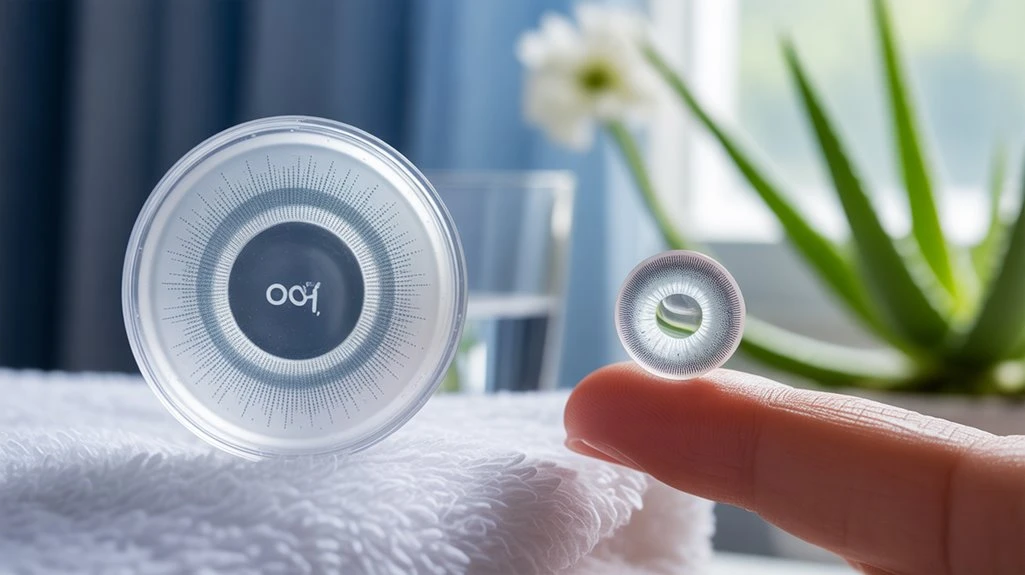
Acuvue Oasys with Hydraclear Plus is a widely recommended contact lens for those experiencing dry eyes. When you’re searching for relief, it’s essential to evaluate lens material options that specifically address hydration performance.
Acuvue Oasys lenses utilize a silicone hydrogel material, designed to allow high oxygen transmission while retaining moisture. The Hydraclear Plus technology integrates a wetting agent directly into the lens, maintaining a consistently smooth surface and minimizing dryness throughout the day.
Clinical studies show that wearers often report reduced dryness symptoms and improved all-day comfort compared to standard hydrogel lenses.
If you’ve struggled with discomfort from other contacts, this lens may offer a noticeable improvement. Remember, your eye care provider can help you determine if this lens material option matches your hydration needs and lifestyle requirements.
For those seeking additional treatment methods, artificial tears remain a common choice for increasing eye moisture, complementing the use of specialized contact lenses.
Dailies Total1 Water Gradient
While many contact lens wearers struggle with dryness, Dailies Total1 Water Gradient lenses offer a unique solution by featuring a gradual increase in water content from core to surface. This innovative design maximizes comfort, especially for those of you with sensitive or dry eyes. The core maintains structural integrity, while the surface approaches nearly 100% water, reducing friction and providing a silky feel. As a daily disposable, Dailies Total1 also simplifies your daily lens care routine, minimizing the risk of deposits and irritation. For those suffering from chronic dry eyes, it might be beneficial to explore solutions that target the root cause of underactive tear production, as complementary treatments can significantly enhance comfort.
| Feature | Benefit |
|---|---|
| Water Gradient Technology | Enhanced moisture retention |
| Daily Disposable | Less risk of protein buildup |
| Smooth Surface | Reduced irritation and friction |
| High Oxygen Permeability | Promotes healthier, whiter eyes |
You’ll find these lenses offer effective relief and lasting comfort.
Biofinity by CooperVision
Biofinity by CooperVision delivers consistent hydration and breathability, making it a strong choice if you experience dry eyes but prefer a monthly replacement schedule.
This lens uses advanced Aquaform® Technology, ensuring your eyes stay moist and comfortable all day. The Biofinity benefits include reduced dryness symptoms and a healthier ocular surface, thanks to its high oxygen permeability.
You’ll appreciate these Biofinity features, especially if you’ve struggled with irritation in the past.
Here are three reasons you might opt for Biofinity:
- Moisture retention: The lens material locks in water, minimizing dryness.
- Breathability: High oxygen transmission supports corneal health, reducing fatigue.
- Convenience: Monthly replacement means fewer changes and less hassle.
Your comfort and ocular health are prioritized with Biofinity’s patient-centered design. In addition to using Biofinity, those experiencing dry eyes might consider artificial tears for temporary relief and to maintain eye moisture.
Bausch + Lomb Ultra With Moistureseal
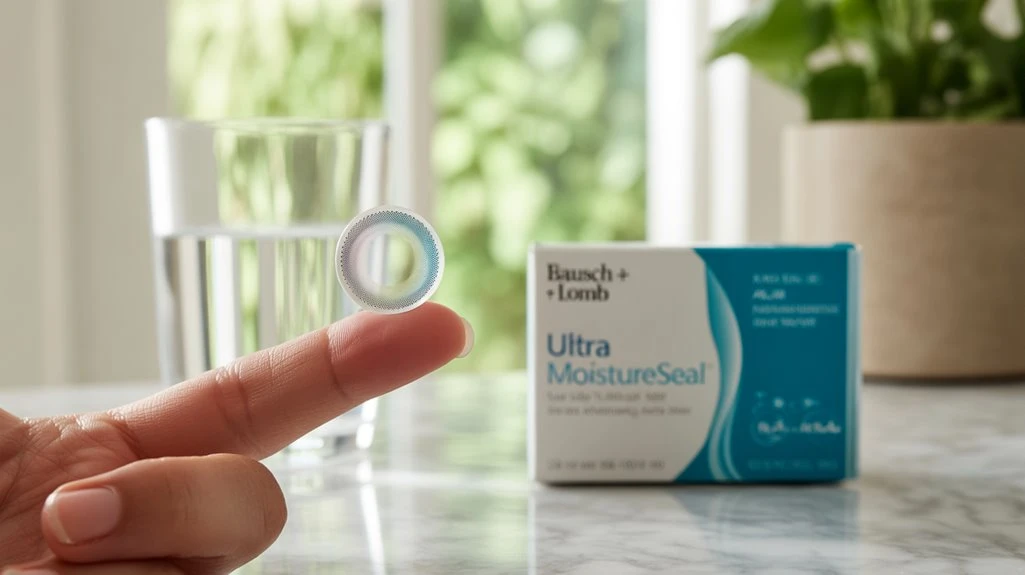
If you’re searching for contact lenses that specifically address dry eye discomfort, Bausch + Lomb Ultra With Moistureseal offers a compelling solution.
These lenses are designed to retain 95% of their moisture for up to 16 hours, providing sustained eye hydration throughout your day. The Moistureseal technology minimizes lens dehydration, which is essential if you experience dryness with other brands.
From a clinical perspective, patients report less dryness and greater comfort, especially during prolonged screen use.
Proper lens maintenance—such as daily cleaning and following your provider’s recommendations—will help maximize the benefits of these lenses and support both comfort and ocular health.
If you need a reliable option to manage dry eye symptoms, Bausch + Lomb Ultra With Moistureseal should be high on your list. Additionally, TheraLife Eye capsules offer a natural alternative by targeting the root cause of dry eyes, enhancing tear production and reducing dryness symptoms.
Air Optix Aqua
Although many contact lenses claim to address dryness, Air Optix Aqua distinguishes itself by combining high oxygen permeability with a smooth surface designed to resist deposits.
If you struggle with dry eyes, you’ll appreciate these Air Optix features, which clinically show enhanced comfort even after hours of wear. The lens material enables more oxygen flow, supporting healthier eyes and less irritation.
Here are three Air Optix benefits you can expect:
- Consistent Moisture Retention: The lens technology helps maintain hydration, reducing dryness throughout your day.
- Deposit Resistance: The ultra-smooth surface minimizes protein and lipid buildup, promoting clearer vision and greater comfort.
- Breathability: High oxygen permeability supports corneal health, making the lenses suitable for extended wear.
These evidence-based advantages make Air Optix Aqua a patient-focused option for dry eye relief. For individuals with autoimmune conditions like Sjogren’s syndrome or rheumatoid arthritis, addressing dry eyes can significantly improve comfort and quality of life.
Proclear by CooperVision
With Proclear by CooperVision, you’ll benefit from unique hydration technology designed to attract and retain moisture on the lens surface. Clinical studies show this feature supports all-day comfort, especially for those prone to dryness. If you’re seeking consistent relief throughout your wear, Proclear may offer a dependable solution. Additionally, wearing contact lenses that maintain a proper balance of all three layers in the tear film can help prevent dry eye symptoms.
Unique Hydration Technology
Proclear by CooperVision claims to feature unique hydration technology designed for contact lens wearers with dry eyes. If you struggle with dryness, you’ll appreciate how Proclear incorporates advanced hydration methods directly into its lens materials.
Clinically, these lenses use phosphorylcholine (PC) technology, which attracts and retains water molecules, helping maintain a moist lens surface throughout wear. This approach targets the underlying causes of dryness rather than just masking symptoms.
A balanced nutritional intake, particularly with omega-3 fatty acids, may support eye health and complement the effectiveness of Proclear lenses in managing dry eyes.
Here are three ways Proclear’s hydration methods stand out:
- PC Technology: Uses naturally occurring molecules to bind water to the lens surface.
- Material Composition: The lens materials are uniquely engineered to resist dehydration, ensuring stable moisture levels.
- Continuous Hydration: Delivers ongoing moisture retention, reducing dryness for sensitive eyes.
These features support a patient-focused strategy for dry eye relief.
All-Day Comfort Benefits
If you’re seeking all-day comfort from your contact lenses, clinical studies show that Proclear by CooperVision may not always deliver sustained relief for every wearer. While Proclear uses advanced lens technology designed to support eye hydration, real-world results can vary. Some patients report improved comfort throughout the day, particularly those with mild to moderate dryness. However, you might still experience end-of-day dryness if your eyes are prone to significant moisture loss. It’s important to recognize that no single lens technology guarantees all-day comfort for everyone. Regular follow-ups with your eye care provider help ascertain you’re using the best lens for your eye hydration needs. If discomfort persists, your provider can recommend alternative options better suited for long-lasting relief. Additionally, addressing blocked glands through warm compresses may enhance the effectiveness of your contact lenses by improving natural tear production and overall eye hydration.
Alcon Precision1 Daily
Many patients seeking daily contact lenses for dry eye relief consider Alcon Precision1 Daily, which features a silicone hydrogel material designed to maintain moisture and breathability throughout the day. If you struggle with dryness, these lenses stand out due to their advanced alcon precision1 features, including SMARTSURFACE® Technology—a micro-thin, high-moisture layer on each lens. This design supports a stable tear film and provides consistent comfort from insertion to removal. Precision1 lens care is straightforward, as you simply use a fresh pair every day, reducing your risk of irritation or deposits. Here’s what makes Alcon Precision1 Daily a top option for dry eyes:
- SMARTSURFACE® Technology maintains lens hydration.
- Silicone hydrogel offers excellent oxygen transmission.
- Daily wear schedule simplifies lens hygiene and care.
For individuals with comorbidities, managing dry eyes effectively is crucial, as it can significantly impact their quality of life and daily activities.
Clariti 1 Day by CooperVision
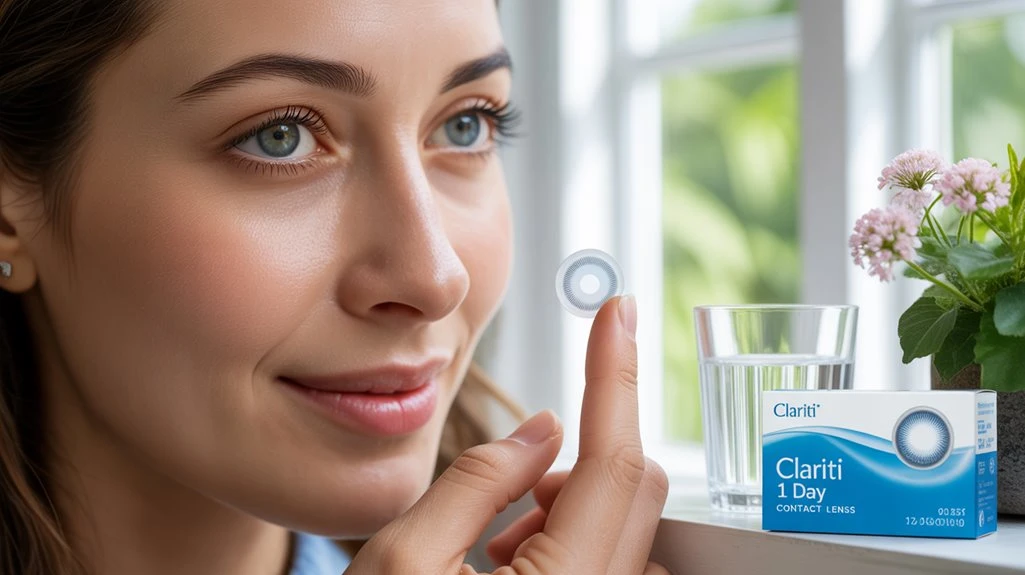
While Alcon Precision1 Daily offers advanced hydration, Clariti 1 Day by CooperVision presents another strong option for those experiencing dry eyes.
If you’ve struggled with discomfort, you’ll appreciate that Clariti 1 Day uses silicone hydrogel lens materials, known for their high oxygen permeability. This helps maintain your eye health over long wear periods.
The lens design also integrates a unique wetting agent throughout the lens material, supporting stable eye hydration all day. Clinical studies show that patients report less dryness and irritation with Clariti 1 Day compared to traditional hydrogel lenses.
Additionally, these lenses provide UV protection as an added benefit. If you’re seeking a daily lens that emphasizes both comfort and eye hydration, Clariti 1 Day could be an excellent fit for your needs.
Dry eyes are the most common eye ailment globally, which makes finding suitable contact lenses crucial for maintaining comfort and eye health.
Biotrue ONEday
Biotrue ONEday lenses offer a daily disposable option designed specifically for patients who experience dryness and discomfort with contact lenses.
If you’ve struggled with keeping your eyes moist throughout the day, you’ll appreciate the biotrue benefits that cater to sensitive, dry eyes. These lenses are crafted with advanced biotrue features such as a material that mimics the natural moisture of your eyes, helping maintain hydration and clarity.
Here’s why Biotrue ONEday is a strong choice for dry eye relief:
- Maintains 98% moisture for up to 16 hours, supporting long-lasting comfort.
- UV protection helps shield your eyes from harmful rays, a vital biotrue benefit.
- Surface active technology resists dehydration, ensuring consistent vision and comfort throughout your day.
Your eyes deserve lasting relief.
MyDay Daily Disposable
With MyDay Daily Disposable lenses, you’ll benefit from advanced moisturizing technology designed to maintain hydration throughout the day.
Clinical studies show that these lenses help minimize dryness and support consistent comfort.
If you’re seeking daily relief from dry eyes, you may find MyDay an effective option.
Advanced Moisturizing Technology
Advanced moisturizing technology sets MyDay Daily Disposable lenses apart for individuals struggling with dry eyes.
You benefit from a lens design that prioritizes moisture retention and lens compatibility, helping reduce the discomfort associated with dryness. The MyDay lenses utilize Smart Silicone™ chemistry, which optimizes oxygen flow and guarantees your eyes stay hydrated throughout the day.
This technology supports your ocular surface health and minimizes irritation.
Here’s why these lenses excel for dry eye relief:
- Enhanced moisture retention: The advanced materials lock in hydration, guaranteeing your eyes remain lubricated.
- Superior lens compatibility: Their design works well with a wide range of eye shapes and tear film compositions.
- Clinically validated performance: Studies show reduced symptoms of dryness and improved overall comfort for daily wearers.
Daily Comfort Experience
Although dry eyes can make contact lens wear challenging, MyDay Daily Disposable lenses deliver consistent comfort throughout the day. If you struggle with dryness, these lenses use advanced comfort strategies to maintain moisture and reduce irritation. Their high breathability guarantees your eyes receive the oxygen they need, which supports healthy eye care and minimizes dryness. You’ll appreciate the soft material that feels natural, even after hours of wear.
| Feature | Clinical Benefit |
|---|---|
| High Oxygen Permeability | Maintains corneal health |
| Moisture Retention | Reduces dryness, enhances comfort |
| Daily Replacement | Minimizes allergen buildup |
Best Oral Dry Eye Treatment That Works With Contact Lenses.
Add To Cart
Frequently Asked Questions
Can I Use Eye Drops With My Contact Lenses for Dry Eyes?
You can use eye drops with your contact lenses, but you must choose the right eye drop types. Not all drops are contact lens compatible—some may cloud your lenses or cause discomfort.
Always select lubricating or rewetting drops labeled as safe for contacts. Avoid medicated or red-eye drops unless your eye care professional recommends them.
Consult your optometrist to guarantee you’re using products that support eye health and lens performance.
How Often Should I Replace Contact Lenses to Prevent Dry Eye Symptoms?
Think of your eyes as gardens—healthy plants thrive when you tend them regularly.
You should follow the recommended lens replacement frequency for your contact lens types; daily disposables minimize dry eye risks, while monthly or bi-weekly lenses require strict schedules to prevent deposits that can worsen symptoms.
Evidence shows frequent replacement supports comfort and eye health.
Always consult your eye care professional to tailor your replacement schedule for ideal dryness relief and safety.
Are There Natural Remedies for Dry Eyes While Wearing Contacts?
If you’re experiencing dry eyes while wearing contacts, you can try home remedies and hydration techniques for relief.
Increase your water intake to support tear production. Use a humidifier to prevent indoor air from drying your eyes. Apply warm compresses to stimulate natural oils in your eyelids.
Practice the 20-20-20 rule to reduce eye strain. However, if symptoms persist, consult your eye care professional for more evidence-based treatment options.
Can Allergies Worsen Dry Eyes With Contact Lens Use?
Yes, allergies can worsen dry eyes when you wear contact lenses.
Allergy symptoms like itching, redness, and increased tear film instability reduce contact comfort and may exacerbate dryness.
Evidence shows allergens can trigger inflammation, leading to reduced tear production and more discomfort.
If you experience these issues, consult your eye care professional. They can recommend strategies to manage allergy symptoms and improve comfort while maintaining eye health with your contact lenses.
Is It Safe to Sleep in Contacts if I Have Dry Eyes?
Think of your eyes as a delicate garden—sleeping in contacts when you have dry eyes is like leaving a protective cover over fragile plants overnight.
It’s not safe for most, as it can worsen dryness and increase infection risk. Some contact lens types are approved for overnight use, but even then, sleeping safety isn’t guaranteed with dry eyes.
Always consult your eye care provider before considering extended wear, prioritizing your eye health above convenience.
Best Oral Dry Eye Treatment That Works With Contact Lenses.
Add To Cart
Conclusion
When it comes to managing dry eyes, TheraLife stands out as the only company offering oral eye treatment care, benefiting customers by addressing the root causes of eye discomfort rather than just the symptoms. Theralife’s comprehensive approach, backed by clinical research, ensures that your eye health is in expert hands. Their products are designed to enhance comfort and improve eye health, offering relief from conditions like blepharitis and uveitis with natural and effective solutions. Prioritize your eye health by consulting with an eye care professional to find the best TheraLife fit—because your vision and comfort deserve nothing less than expert care.
References
- 1.
- The definition and classification of dry eye disease: report of the Definition and Classification Subcommittee of the International Dry Eye WorkShop (2007). Ocul Surf. 2007 Apr;5(2):75-92. [PubMed]
- 2.
- Huang R, Su C, Fang L, Lu J, Chen J, Ding Y. Dry eye syndrome: comprehensive etiologies and recent clinical trials. Int Ophthalmol. 2022 Oct;42(10):3253-3272. [PMC free article] [PubMed]
- 3.
- Craig JP, Nichols KK, Akpek EK, Caffery B, Dua HS, Joo CK, Liu Z, Nelson JD, Nichols JJ, Tsubota K, Stapleton F. TFOS DEWS II Definition and Classification Report. Ocul Surf. 2017 Jul;15(3):276-283. [PubMed]
- 4.
- King-Smith PE, Fink BA, Hill RM, Koelling KW, Tiffany JM. The thickness of the tear film. Curr Eye Res. 2004 Oct-Nov;29(4-5):357-68. [PubMed]
- 5.
- King-Smith PE, Fink BA, Fogt N, Nichols KK, Hill RM, Wilson GS. The thickness of the human precorneal tear film: evidence from reflection spectra. Invest Ophthalmol Vis Sci. 2000 Oct;41(11):3348-59. [PubMed]
- 6.
- Chen Q, Wang J, Tao A, Shen M, Jiao S, Lu F. Ultrahigh-resolution measurement by optical coherence tomography of dynamic tear film changes on contact lenses. Invest Ophthalmol Vis Sci. 2010 Apr;51(4):1988-93. [PMC free article] [PubMed]
- 7.
- Willcox MDP, Argüeso P, Georgiev GA, Holopainen JM, Laurie GW, Millar TJ, Papas EB, Rolland JP, Schmidt TA, Stahl U, Suarez T, Subbaraman LN, Uçakhan OÖ, Jones L. TFOS DEWS II Tear Film Report. Ocul Surf. 2017 Jul;15(3):366-403. [PMC free article] [PubMed]
- 8.
- Peng CC, Cerretani C, Braun RJ, Radke CJ. Evaporation-driven instability of the precorneal tear film. Adv Colloid Interface Sci. 2014 Apr;206:250-64. [PubMed]
- 9.
- Zhou L, Beuerman RW. Tear analysis in ocular surface diseases. Prog Retin Eye Res. 2012 Nov;31(6):527-50. [PubMed]
- 10.
- Mantelli F, Mauris J, Argüeso P. The ocular surface epithelial barrier and other mechanisms of mucosal protection: from allergy to infectious diseases. Curr Opin Allergy Clin Immunol. 2013 Oct;13(5):563-8. [PMC free article] [PubMed]
- 11.
- O’Neil EC, Henderson M, Massaro-Giordano M, Bunya VY. Advances in dry eye disease treatment. Curr Opin Ophthalmol. 2019 May;30(3):166-178. [PMC free article] [PubMed]
- 12.
- Fjaervoll K, Fjaervoll H, Magno M, Nøland ST, Dartt DA, Vehof J, Utheim TP. Review on the possible pathophysiological mechanisms underlying visual display terminal-associated dry eye disease. Acta Ophthalmol. 2022 Dec;100(8):861-877. [PMC free article] [PubMed]
- 13.
- Craig JP, Nelson JD, Azar DT, Belmonte C, Bron AJ, Chauhan SK, de Paiva CS, Gomes JAP, Hammitt KM, Jones L, Nichols JJ, Nichols KK, Novack GD, Stapleton FJ, Willcox MDP, Wolffsohn JS, Sullivan DA. TFOS DEWS II Report Executive Summary. Ocul Surf. 2017 Oct;15(4):802-812. [PubMed]
- 14.
- Qian L, Wei W. Identified risk factors for dry eye syndrome: A systematic review and meta-analysis. PLoS One. 2022;17(8):e0271267. [PMC free article] [PubMed]
- 15.
- I Y Hasan ZA. Dry eye syndrome risk factors: A systemic review. Saudi J Ophthalmol. 2021 Apr-Jun;35(2):131-139. [PMC free article] [PubMed]
- 16.
- Paulsen AJ, Cruickshanks KJ, Fischer ME, Huang GH, Klein BE, Klein R, Dalton DS. Dry eye in the beaver dam offspring study: prevalence, risk factors, and health-related quality of life. Am J Ophthalmol. 2014 Apr;157(4):799-806. [PMC free article] [PubMed]
- 17.
- Chang CJ, Somohano K, Zemsky C, Uhlemann AC, Liebmann J, Cioffi GA, Al-Aswad LA, Lynch SV, Winn BJ. Topical Glaucoma Therapy Is Associated With Alterations of the Ocular Surface Microbiome. Invest Ophthalmol Vis Sci. 2022 Aug 02;63(9):32. [PMC free article] [PubMed]
- 18.
- Andole S, Senthil S. Ocular Surface Disease and Anti-Glaucoma Medications: Various features, Diagnosis, and Management Guidelines. Semin Ophthalmol. 2023 Feb;38(2):158-166. [PubMed]
- 19.
- Sobolewska B, Schaller M, Zierhut M. Rosacea and Dry Eye Disease. Ocul Immunol Inflamm. 2022 Apr 03;30(3):570-579. [PubMed]
- 20.
- Bilgic AA, Kocabeyoglu S, Dikmetas O, Tan C, Karakaya J, Irkec M. Influence of video display terminal use and meibomian gland dysfunction on the ocular surface and tear neuromediators. Int Ophthalmol. 2023 May;43(5):1537-1544. [PubMed]
- 21.
- Al Sabti K, Zechevikj S, Raizada S. Evaluation of lipid layer tear film changes after femtosecond small incision lenticule extraction. Ther Adv Ophthalmol. 2022 Jan-Dec;14:25158414221129534. [PMC free article] [PubMed]
- 22.
- Napoli PE, Nioi M, Iovino C, Sanna R, d’Aloja E, Fossarello M. Ocular surface and respiratory tract damages from occupational, sub-chronic exposure to fluorspar: case report and other considerations. Int Ophthalmol. 2019 May;39(5):1175-1178. [PubMed]
- 23.
- Suárez-Cortés T, Merino-Inda N, Benitez-Del-Castillo JM. Tear and ocular surface disease biomarkers: A diagnostic and clinical perspective for ocular allergies and dry eye disease. Exp Eye Res. 2022 Aug;221:109121. [PubMed]
- 24.
- Truong S, Cole N, Stapleton F, Golebiowski B. Sex hormones and the dry eye. Clin Exp Optom. 2014 Jul;97(4):324-36. [PubMed]
- 25.
- Talens-Estarelles C, García-Marqués JV, Cerviño A, García-Lázaro S. Dry Eye-Related Risk Factors for Digital Eye Strain. Eye Contact Lens. 2022 Oct 01;48(10):410-415. [PubMed]

